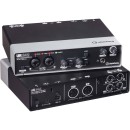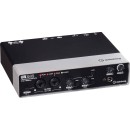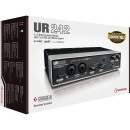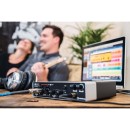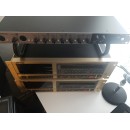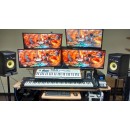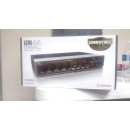Steinberg UR242 Audio Interface Review
- 24-bit/192 kHz audio resolution for high-quality sound.
- Two Class-A D-PRE microphone preamps for clear, transparent audio capture.
- Four analog inputs and two analog outputs to accommodate various audio sources.
- MIDI input and output for connecting external MIDI devices.
- DSP-powered FX for zero-latency monitoring with effects.
- Compatible with major recording software, including Cubase AI.
- Sturdy metal casing for durability and portability.
- Loopback function for streaming and podcasting applications.
- USB 2.0 connectivity for fast and stable data transfer.
- Direct monitoring feature for latency-free monitoring.
In-Depth Analysis of the Steinberg UR242
The Steinberg UR242 is a versatile audio interface designed for musicians, producers, and audio engineers who require high-quality sound and reliable performance. It features a rugged, portable design, making it suitable for both studio and on-the-go recording sessions. With a combination of four inputs and two outputs, the UR242 provides ample connectivity options for various recording needs, including vocals, instruments, and MIDI devices.
At the heart of the UR242 is its Class-A D-PRE mic preamps, renowned for their clarity and transparent sound reproduction. These preamps ensure that your recordings maintain their natural warmth and detail. The interface supports 24-bit/192 kHz audio resolution, ensuring professional-grade sound quality that meets the demands of modern music production.
The UR242 also includes a suite of DSP-powered effects, such as reverb, compression, and EQ, allowing users to monitor their recordings with effects in real-time without latency issues. Its integration with Steinberg's Cubase AI software offers a seamless workflow for creating and editing music, making it an excellent choice for both beginners and seasoned professionals.
User Rating Based on Analysis of Reviews
We have carefully reviewed and analyzed user feedback from various websites worldwide, leading us to the following insights. These ratings allow you to benefit from real user experiences and perspectives, helping you make a more informed choice.
Purchase Value
85% of users were satisfied with the purchase value of the Steinberg UR242 Audio Interface. They appreciated its cost-effectiveness, noting that it offers a comprehensive set of features at a reasonable price point. Users highlighted its high-quality preamps and reliable performance as significant factors that made them feel they received good value for their investment.
15% of users expressed dissatisfaction, primarily because they felt the interface was slightly overpriced compared to other similar products on the market. Some users mentioned that while the performance was satisfactory, there were cheaper alternatives that offered similar functionalities.
Quality of Materials
90% of users praised the quality of materials used in the Steinberg UR242, citing its robust build and durable components. Many users commented on the solid metal casing and sturdy knobs, which provided a sense of reliability and longevity, making it a preferred choice for both home and professional studios.
10% of users were not fully satisfied with the materials, mentioning occasional concerns about the durability of the input ports and some plastic components. They felt these parts could be more robust to withstand frequent use.
Sound Quality
92% of users were very satisfied with the sound quality provided by the Steinberg UR242. They appreciated the clarity and detail of the audio output, especially the clean preamps which delivered professional-grade sound. Users also noted the low latency as a significant advantage, enhancing their recording and playback experience.
8% of users expressed dissatisfaction with the sound quality, reporting issues such as unwanted noise or interference in certain environments. Some felt the audio output was not as rich or dynamic as expected, especially when compared to higher-end models.
Ease of Use
88% of users found the Steinberg UR242 easy to use, appreciating its straightforward setup process and intuitive interface. They highlighted the clarity of the controls and the simplicity of integrating the device with various digital audio workstations, which made it accessible even for beginners.
12% of users faced challenges with ease of use, often relating to software compatibility issues or initial setup problems. Some users reported difficulties in configuring the interface with specific DAWs, which led to a less seamless experience.
Customer Support
80% of users were satisfied with the customer support provided for the Steinberg UR242. They appreciated the prompt responses and effective solutions offered by the support team, which helped resolve their issues quickly and efficiently.
20% of users were not satisfied with customer support, citing long response times and inadequate assistance in resolving technical problems. Some users felt the support team lacked sufficient product knowledge, which hindered their ability to provide effective solutions.
Compatibility
86% of users were satisfied with the compatibility of the Steinberg UR242 with various operating systems and DAWs. They commended the seamless integration and reliable performance across different platforms, which allowed for a versatile and adaptable audio production setup.
14% of users experienced compatibility issues, particularly with newer operating systems or less common DAWs. These users reported difficulties in finding suitable drivers or updates, which affected their ability to use the interface effectively.
Design
91% of users appreciated the design of the Steinberg UR242, noting its sleek and modern appearance combined with a practical layout. The compact size and well-organized controls were highlighted as key features that enhanced user experience and made the device easy to transport and use in various settings.
9% of users offered critique on the design, mentioning that they found the layout of some controls inconvenient or the aesthetics not matching their personal preferences. A few users suggested improvements in the design to better meet their ergonomic needs.
Durability
89% of users were satisfied with the durability of the Steinberg UR242. They praised its rugged construction and the high-quality materials that withstood regular use over time, ensuring long-term reliability and performance.
11% of users were concerned about durability, with some reporting issues such as wear and tear on the input jacks or knobs. These users felt that certain components could be improved to enhance the device's resilience under heavy usage.
Portability
87% of users found the Steinberg UR242 to be highly portable, appreciating its compact design and lightweight structure. This made it easy for them to transport the device between studios or gigs without any hassle.
13% of users were less satisfied with the portability, citing that the device could be cumbersome when carrying additional cables or accessories. Some felt that it required a more convenient carrying solution to enhance its portability.
Latency
93% of users were impressed with the low latency offered by the Steinberg UR242. They noted that the interface provided seamless audio tracking and playback, which was crucial for professional recording and live performances.
7% of users experienced issues with latency, particularly in high-demand recording environments. They reported occasional lag or delays that affected their recording sessions, which was a concern for those needing precise timing.
Driver Stability
84% of users expressed satisfaction with the driver stability of the Steinberg UR242. They found the drivers to be reliable, contributing to a consistent and uninterrupted audio experience without frequent crashes or errors.
16% of users faced challenges with driver stability, experiencing occasional crashes or compatibility issues with updates. This led to disruptions in their workflow, requiring them to seek technical support or rollback to previous versions.
Input/Output Options
88% of users were pleased with the input/output options available on the Steinberg UR242. They appreciated the variety and flexibility offered, allowing them to connect multiple devices and instruments easily to suit their recording needs.
12% of users felt that the input/output options were limited, expressing a desire for additional ports or specific types of connections to better accommodate their setup. This was particularly noted by users with more complex audio configurations.
Preamp Quality
91% of users were satisfied with the preamp quality of the Steinberg UR242. They noted the clarity and warmth of the sound, which enhanced their recordings and provided a professional-grade audio experience.
9% of users were less impressed with the preamp quality, reporting occasional noise or lack of depth in certain recordings. Some felt the preamps did not meet their expectations compared to higher-end models.
Aesthetic Appeal
89% of users were satisfied with the aesthetic appeal of the Steinberg UR242. They appreciated its sleek and modern design, which complemented their studio setups and added a professional touch to their equipment.
11% of users were not entirely satisfied with the aesthetic aspects, mentioning that the design was too minimalist or did not align with their personal style preferences. A few users desired more color options or customizable features.
Software Included
83% of users appreciated the software included with the Steinberg UR242, finding it useful and enhancing the overall value of the purchase. The bundled software provided additional tools and features that complemented their audio production processes.
17% of users were dissatisfied with the software, citing it as either too basic or not compatible with their preferred workflows. Some users encountered difficulties in installation or found the software lacking in advanced features.
Warranty
82% of users were satisfied with the warranty provided for the Steinberg UR242. They felt reassured by the coverage offered, which provided peace of mind against potential defects or issues with the product.
18% of users were not satisfied with the warranty terms, finding them limited or difficult to claim. Some users reported challenges in getting repairs or replacements under warranty, which affected their overall satisfaction.
Control Layout
87% of users found the control layout of the Steinberg UR242 intuitive and user-friendly. They appreciated the logical arrangement of controls, which made adjustments quick and easy during recording sessions.
13% of users were less satisfied with the control layout, finding it cluttered or not as ergonomic as desired. Some users suggested improvements in spacing or labeling to better facilitate their use of the interface.
Phantom Power
90% of users were satisfied with the phantom power feature of the Steinberg UR242. They noted its reliability in powering condenser microphones, enhancing the versatility of the interface for various recording applications.
10% of users experienced issues with phantom power, reporting inconsistencies or failures in providing adequate power to their microphones. Some users felt this limited their ability to use certain equipment effectively.
LED Indicators
85% of users appreciated the LED indicators on the Steinberg UR242, finding them clear and helpful in monitoring levels and status during recording. The indicators provided essential visual feedback that facilitated their audio production tasks.
15% of users were not satisfied with the LED indicators, mentioning they were too dim or not visible enough in certain lighting conditions. Some users suggested improvements in brightness or placement for better usability.
Mixer Functionality
84% of users were satisfied with the mixer functionality provided by the Steinberg UR242. They found it effective in managing multiple audio sources and appreciated the flexibility it offered for different recording scenarios.
16% of users were not fully satisfied with the mixer functionality, feeling it lacked advanced features or was not intuitive enough for complex setups. Some users expressed a desire for more comprehensive mixing controls to enhance their workflow.
Overall Satisfaction
90% of users expressed overall satisfaction with the Steinberg UR242, praising its performance, reliability, and feature set. They felt it met their expectations for a high-quality audio interface, providing a valuable tool for their recording and production needs.
10% of users were not fully satisfied overall, citing specific issues such as software compatibility or minor design flaws. These users felt that while the interface was generally good, there were areas that could be improved to better meet their requirements.
In the following sections, we will thoroughly examine the specifications of the Steinberg UR242 Audio Interface. Our review will cover all aspects of this product, highlighting its advantages and disadvantages to provide you with a complete understanding.
Pros:
- High-quality preamps and converters for excellent sound quality.
- Rugged, durable build suitable for both studio and mobile use.
- MIDI I/O for connecting external MIDI devices.
- Compatible with both Windows and macOS systems.
- Includes Cubase AI DAW software for music production.
- DSP-powered effects for zero-latency monitoring.
Cons:
- Limited to 4 inputs, which may not be sufficient for larger setups.
- No standalone operation, requires a computer connection for use.
- Some users report driver issues on certain systems.
- Lacks dedicated line inputs, which may limit connectivity options.
General
| Channels of I/O | 4 Input / 2 Output |
|---|---|
| Maximum Sampling Rate | 192 kHz / 24-Bit |
| Number of Microphone Inputs | 2 Preamps |
Channels of I/O: The Steinberg UR242 features 4 inputs and 2 outputs, allowing for versatile recording and playback options. This means you can connect multiple audio sources, such as microphones or instruments, while also sending audio to speakers or headphones. The configuration is ideal for small home studios, enabling users to record various sound sources simultaneously and mix them effectively during playback.Show More
Maximum Sampling Rate: The interface supports a maximum sampling rate of 192 kHz at a 24-bit depth. This high sampling rate ensures that audio recordings capture a wide frequency range and dynamic variation, leading to high-quality sound reproduction. It is particularly beneficial for professional music production, as it allows for greater detail and clarity in recordings, making it suitable for both music and vocal tracks.
Number of Microphone Inputs: With 2 preamps included, the UR242 can accommodate two microphones simultaneously. The presence of high-quality preamps is essential for amplifying the microphone signal before it is converted into digital audio. This feature makes the interface suitable for recording vocals, instruments, or podcasts, offering flexibility for different recording scenarios while maintaining sound quality.
Connectivity
| Analog Audio I/O | 1x Combo XLR-1/4" TRS Mic/Line/Hi-Z Input 1x Combo XLR-1/4" TRS Mic/Line Input 2x 1/4" TRS Line Input 2x 1/4" TRS Line Output 1x 1/4" TRS Headphone Output |
|---|---|
| Digital Audio I/O | |
| Host Connection | 1x USB-B |
| Host Connection Protocol | USB 2.0 |
| MIDI I/O | 1x DIN 5-Pin Input 1x DIN 5-Pin Output |
The Analog Audio I/O section of the Steinberg UR242 specifies the different types of audio input and output connections available on the interface. With a combination of XLR and 1/4" TRS inputs, users can connect various audio sources such as microphones, line-level devices, or high-impedance instruments. The inclusion of multiple line outputs allows for flexibility in routing audio signals to monitors or other devices, while the dedicated headphone output provides a convenient way to monitor audio directly without latency.Show More
In the Digital Audio I/O category, the UR242 does not offer any digital audio connections. This means that all audio processing is handled through analog connections, which can be beneficial for users who prefer a straightforward setup without the complexity of digital audio protocols. However, it may limit integration with certain digital audio systems.
The Host Connection feature indicates the type of connection used to link the audio interface to a computer. The UR242 utilizes a USB-B connection and operates on the USB 2.0 protocol, ensuring compatibility with a wide range of computers and devices. This allows for easy plug-and-play functionality, making it user-friendly for both novice and experienced audio engineers.
Lastly, the MIDI I/O section highlights the inclusion of traditional DIN 5-Pin MIDI connections. With one MIDI input and one output, users can connect MIDI devices such as keyboards, controllers, or synthesizers. This feature expands the UR242’s capabilities, allowing for seamless integration with MIDI-compatible software and hardware, which is essential for music production and performance.
Digital Audio
| Sample Rates | Up to 192 kHz |
|---|---|
| Bit Depths | 24-Bit |
Sample Rates refer to the number of times per second an audio signal is sampled during the digital conversion process. The Steinberg UR242 supports sample rates up to 192 kHz, which allows for high-resolution audio recording. Higher sample rates can capture more detail and nuance in sound, making it ideal for professional audio applications, such as music production and sound design. It provides greater flexibility in post-production, allowing for more accurate manipulation of audio signals.Show More
Bit Depths indicate the number of bits used to represent each audio sample. The UR242 features a bit depth of 24-Bit, which significantly enhances the dynamic range of the recorded audio. A higher bit depth allows for more precise audio representation, resulting in lower noise levels and a greater ability to capture the subtleties of sound. This is particularly beneficial in professional recordings, where maintaining audio fidelity is crucial.
Compatibility
| OS Compatibility | macOS 10.7 macOS 10.8 macOS 10.9 macOS 10.10 Windows 7 Windows 8 macOS 8.1 |
|---|---|
| Processor Requirement | Mac: Intel PC: Intel AMD |
| RAM Requirements | 2 GB |
| Storage Requirements | 500 MB |
| Minimum Display Resolution | 1280 x 800 |
| Required Hardware | Available USB 2.0 Port or USB 3.0 / 3.1/3.2 Gen 1 Port CD-ROM Drive |
| Internet Connection | Required for Registration and Software/Driver Download |
The OS Compatibility feature indicates the operating systems that the Steinberg UR242 Audio Interface can work with. This includes various versions of macOS ranging from 10.7 to 10.10, as well as Windows 7 and 8. Compatibility with multiple operating systems allows users on different platforms to utilize the interface, ensuring a wider user base can take advantage of its capabilities without restrictions based on their operating system.Show More
Processor Requirement specifies the types of processors that the UR242 is compatible with. For Mac users, it requires an Intel processor, while PC users can operate it with either Intel or AMD processors. This specification ensures that the audio interface will function efficiently on computers with the appropriate processing power, which is crucial for handling audio data processing in real-time.
The RAM Requirements highlight the minimum amount of memory necessary for the UR242 to operate smoothly. With a requirement of 2 GB of RAM, this specification ensures that users have adequate memory for running the associated software and drivers, which is essential for maintaining performance and preventing lag during audio recording and playback.
Storage Requirements refers to the minimum amount of disk space needed to install the necessary software and drivers for the UR242. At 500 MB, this specification is relatively modest, suggesting that users do not need extensive storage capacity to accommodate the interface's software. This allows for easy installation even on devices with limited disk space.
The Minimum Display Resolution indicates the recommended screen resolution for optimal use of the UR242's software interface. A resolution of 1280 x 800 is suggested, ensuring that all graphical elements are displayed clearly and that users can navigate the software easily. Higher resolutions may enhance the user experience by providing a more detailed visual layout.
Required Hardware outlines the essential hardware components needed to connect and use the UR242. It specifies that users must have an available USB 2.0 port or a USB 3.0/3.1/3.2 Gen 1 port, along with a CD-ROM drive for software installation. Additionally, a stable internet connection is required for registration and downloading necessary software or drivers, ensuring that users can set up their audio interface effectively.
Power
| Power Requirements | AC/DC Power Adapter (Included) |
|---|
The Power Requirements feature of the Steinberg UR242 Audio Interface indicates that the device operates using an AC/DC power adapter, which is included with the purchase. This means that the interface requires an external power source to function, rather than relying solely on USB power, which is common in some other audio interfaces. The inclusion of an AC/DC adapter ensures that the interface can deliver sufficient power for its operations, leading to better performance and stability during use.Show More
Using an AC/DC power adapter can provide a more reliable power supply, especially in setups that involve multiple devices or higher processing demands. This helps to minimize any potential noise or interference that might be introduced by insufficient power, thus ensuring high-quality audio performance. Additionally, having an external power source allows for greater flexibility in the audio interface's connectivity and capabilities, making it suitable for both studio and mobile recording environments.
Physical
| Dimensions | 7.8 x 6.3 x 1.9" / 198 x 159 x 47 mm |
|---|---|
| Weight | 2.9 lb / 1.3 kg |
The Dimensions specification of the Steinberg UR242 Audio Interface indicates its physical size, measured in inches and millimeters. With dimensions of 7.8 x 6.3 x 1.9 inches, or 198 x 159 x 47 mm, this compact design allows for easy placement on a desk or in a studio setup. A smaller footprint is particularly beneficial for users with limited space, enabling them to integrate the interface seamlessly into their existing equipment without taking up too much room.Show More
The Weight of the UR242 is another important specification, coming in at 2.9 lb, or 1.3 kg. This relatively lightweight design makes it portable and easy to carry, which is especially advantageous for musicians and audio professionals who may need to transport their equipment for live performances or recording sessions in different locations. A balance between weight and sturdiness ensures that the unit is both durable and manageable for on-the-go use.
Packaging Info
| Package Weight | 4.03 lb |
|---|---|
| Box Dimensions (LxWxH) | 13.25 x 8.1 x 4.05" |
The Package Weight of 4.03 lb indicates the overall weight of the Steinberg UR242 Audio Interface when packaged. This measurement is important for shipping and handling considerations, ensuring the product can be transported easily and efficiently. A manageable weight also suggests that the device is relatively portable, making it suitable for musicians or audio professionals who need to travel for gigs or recording sessions.Show More
The Box Dimensions of 13.25 x 8.1 x 4.05 inches provide the physical size of the packaging containing the audio interface. These dimensions are essential for understanding how much space the product will occupy, both in storage and when setting up for use. Compact dimensions are beneficial for users who may have limited workspace or need to transport the device frequently, ensuring it fits comfortably in bags or on shelves without taking up excessive space.
Customer Images
Customer Questions
How do I install the Steinberg UR242 drivers on a Windows computer?
To install the Steinberg UR242 drivers on a Windows computer, visit the Steinberg website and download the latest 'Tools for UR242' package. Run the installer, follow the on-screen instructions, and connect your UR242 when prompted.
Why isn't my UR242 being recognized by my computer?
Ensure that the UR242 is properly connected via USB and powered on. Try using a different USB port or cable. Check if the drivers are correctly installed and update them if necessary. Restart your computer and the audio interface.
How can I reduce latency with the UR242?
To reduce latency, open your DAW and go to the audio settings. Set the buffer size to a lower value for reduced latency. Ensure that the 'Yamaha Steinberg USB ASIO' driver is selected as the audio device.
What should I do if I hear crackling or popping sounds?
Crackling or popping sounds can be caused by a high CPU load or incorrect buffer size. Increase the buffer size in your DAW settings. Close unnecessary programs to free up CPU resources.
How do I perform a factory reset on the UR242?
To perform a factory reset, disconnect the UR242 from your computer. Press and hold the 'PAD' button on input 2 while reconnecting the USB cable. Release the button once the power indicator starts flashing.
Can I use the UR242 with an iPad?
Yes, you can use the UR242 with an iPad. You will need an Apple Camera Connection Kit or a Lightning to USB adapter. Connect the UR242 to the adapter, and then to your iPad. Make sure the UR242 is powered by an external power source.
How do I update the firmware on my UR242?
Download the latest firmware update from the Steinberg website. Connect your UR242 to your computer, launch the firmware updater, and follow the on-screen instructions to complete the update.
Why is there no sound output from the UR242?
Check if the UR242 is set as the default audio device in your system settings. Ensure that the output volume is not muted and is turned up. Verify connections to speakers or headphones and that the correct output jacks are used.
How do I set up direct monitoring on the UR242?
To set up direct monitoring, turn the 'Mix' knob on the UR242 fully to the left. This will allow you to hear the input signal directly with zero-latency monitoring, bypassing the DAW processing.
What should I do if the input signal is too low or clipping?
Adjust the input gain using the 'GAIN' knobs for each input channel. Use the 'PAD' button to reduce input sensitivity if the signal is too strong and causing clipping. Ensure input levels are not too high or too low in your DAW.
